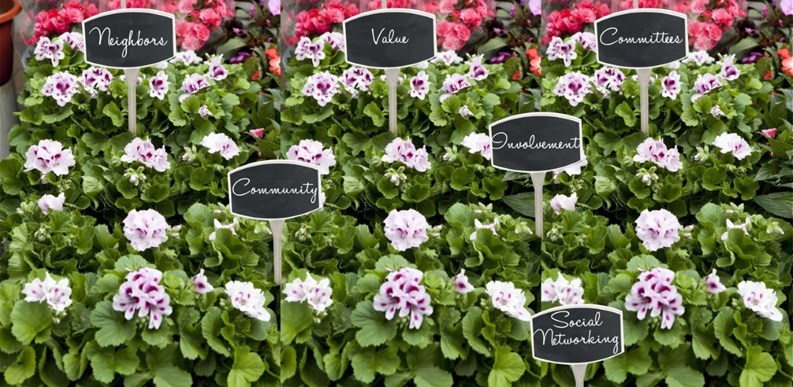The word community, like many words in the English language, has more than one interpretation. A community can be identified as a geographical location—a physical infrastructure of streets, parks and buildings, defined by tangible brick and mortar structures. But a sense of community is often emotional, intangible and much more difficult to define; it is what makes an address a home, not just a location.
“There are so many benefits of community building,” says Paul A. Santoriello, PCAM, president of Taylor Management Company in Whippany. “When you look at the value of where you live there is of course the mortar and bricks aspect of it, the structure and the location. But when you really look at the total happiness you derive from where you live, the sense of community is very, very important.”
“Living in a community everyone has a shared interest and a financial interest in their community at large,” says Martin H. Laderman, president of mem property management corporation in Jersey City. “So it’s in everyone’s best interest not to live in a hostile environment. A friendly environment not only makes it more enjoyable but it also makes it more easier to sell and raise a family.”
Alone Together
Cultivating a sense of community can present a challenge for residents, property managers and homeowners associations. In a sprawling urban/suburban environment, the fact that people live side-by-side with each other certainly doesn’t prevent them from feeling isolated and disconnected from their neighbors. High-rise residential buildings put many people and families in very close proximity to one another, but don’t automatically turn a group of people into a community—sometimes they even have the opposite effect.
Lives are busy and schedules hectic, and the last thing many people want to do when they’re at home on a weekend or after a long day at work is go socialize with their neighbors. Building a sense of community is valuable, however, it creates a network of communication and support among building residents.
“It’s up to the board and managing agent, working together, to instill the feeling of community,” says Marni Berk, general manager and team leader for FirstService Residential, one of the nation’s largest property management companies, that has properties throughout New Jersey. “The board supplies the focus and the agent is available for the follow-up and follow-through.”
“A harmonious community typically is something that starts at the board level and trickles down to the community,” says Santoriello. “First, it needs to start with the attitude of the board and the manager. We always say we are there to serve the unit owners or shareholders of the community, and we take direction from the board. It’s important for the board and for the management to be there collectively, to serve the community as a whole - and one of the services that we should be involved in is building community.”
Not fostering a sense of community can have detrimental effects on an association. “If you don’t have a sense of community you can get a very apathetic membership,” says Santoriello. “You may have a situation where you are more easily divided. If you have a sense of community, residents are usually trying to work for a common cause.”
Building Community
A sense of community doesn’t automatically come along with the purchase of a unit, or on move-in day. There has to be a vested interest in cultivating and creating that hard to define but valuable support system among residents. Chances are you will not find “foster a sense of community” in any one person’s job description. Creating that special feeling of connectivity tends to be a group effort, and requires a team approach.
Berk is also in favor of using a committee approach and involving interested residents in building or association decisions whenever possible. “The board will make the final decision, but committees allow others to have a voice,” she explains. “Committees can lighten the workload, and having shareholders involved also helps build a sense of community, and community pride.”
Experts agree on the importance of committees for building community relations and that two of the most important committees are a social committee and a welcome committee.
“One of the buildings that I manage is going to have a Super Bowl party in the community room,” says Laderman. “That is great. A bunch of residents with a shared interest is going to get together and do something that they all enjoy. That’s a good example of community builidng.”
In Berk’s experience, many residents have valuable skills to contribute, but she cautions, “Even with a committee, you cannot please everyone.” Still, she believes the involvement tends to make people feel good about where they live, and residents are then more likely to pick up after their pets, or check on a neighbor, and take better care of the property in general. “Involvement helps build a different environment,” she says.
There are also economic benefits to community building. “It is also important to a realtor,” explains Santoriello, “The public at large, they typically decide on the community first and then they look at units within that community. A large part of the value of that community is how residents get along.”
Web-Savvy
Along with face-to-face committee organization, Berk uses mybuilding.org as an electronic communications system to bring residents together. MyBuilding provides a custom website with all documents, updates and information about the property, and the neighborhood continuously updated by the property manager and the website's support team.
Residents can login with a private password to receive updates and to communicate with building management, or submit maintenance requests. Berk uses this as a tool to keep residents informed on all levels, both social and maintenance. She tries to proactively anticipate the questions surrounding any posting and have the answers readily available. Answers to questions like “How long will the air conditioning be serviced?” or “Where is the clothing donation bin now located?” can reassure resident owners and shareholders, and strengthen a sense of community by effectively saying “we care about you.”
“The web is no doubt a great tool in building community,” agrees Santoriello. “One of the most important things that a board can do to help develop a sense of community and a sense of trust in the board is to be transparent. And you do that by providing as much information in an easily obtainable format for all residents to see. The web, Facebook and social media tends to be very good tools for communicating. The best way to build community is to communicate and those types of tools are extremely helpful when communicating.”
Berk recently sent that message loud a clear when she arranged for a fire-safety awareness event for the buildings she manages. She also promotes Project Open, a resource for senior residents to keep them informed of outings and interactions, and she is aware of the who, what and where of resident-arranged activities like reading groups, card and movie nights, and mahjong games.
One of the buildings Berk manages has re-named a multi-purpose room, the “play-munity room.” This adaptable space can be divided into two areas to effectively provide for events and socials. “Not every building will have space to promote and share these activities, but if a gym or community room is available, residents and management can work out some regularly scheduled events,” she says.
Anyone looking to grow a sense of community can benefit from looking at the opportunities for social interaction Berk and her team members have fostered. In one community, major holidays are recognized and celebrated in every building, all cultures are represented, and the children are encouraged to make decorations and help decorate the common areas. Board members and managers are encouraged to regularly attend social gatherings and holiday parties. “Socials provide an opportunity for interaction with residents and neighbors in an informal setting,” Berk explains. “There is an opportunity we don’t normally see during regular business hours.”
“A website is a great communication tool to get the word out fast,” says Laderman. “There’s also an option on websites where you have the option of selling something, like furniture or a mattress. It’s a great way for residents to communicate with each other. It’s a good way to get the building talking to each other and that establishes a sense of community living. It’s a great way for neighbors to communicate with each other.”
Everything from yoga classes to crafts, and holiday parties can enhance a sense of community and make a property more appealing for residents and management. Many property managers likes to see committees involved in selecting activities and classes for community involvement. One board member will typically be in charge of a committee in order to provide seamless communication between the committee and the board.
When there is a defined sense of community and ownership residents usually take more interest in the care and maintenance of the property. If there is a loss of the sense of community, it can transfer to a lack of interest and affect the real and perceived value of a property.
Anne Childers is a freelance writer and a frequent contributor to The New Jersey Cooperator. Staff Writer Christy Smith-Sloman contributed to this article.







Leave a Comment